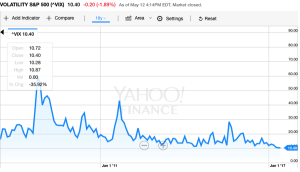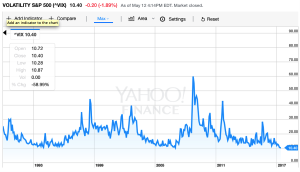The VIX Will Achieve Its Lowest Levels Ever...In Time
You’ve heard me say it time and time again, read it maybe a couple dozen times and possibly benefited from it when it has or will come to fruition: “Volatility or the VIX can remain complacent for far longer than it expresses high levels of fear”. Given that statement and the nature of volatility being what it is, you probably guessed, if you are reading my works for the first time, I’m short volatility and have been for many years. In fact, my greatest short position in both size and ROIC is ProShares Ultra VIX Short-Term Futures ETF (UVXY). UVXY is a short, VIX-Leveraged ETF that benefits from a correlation and collection of VIX Futures contracts. It is designed to decay in share price over time. The chart below offers a review of the VIX over the last 30-day period.

On May 8th the VIX hit a multi-year low of 9.67 before finally spiking to just over 11 in a few days on May 11th. Regardless of what month and what year, the monthly chart will generally look as it does in the above chart a vast majority of the time. Below is a chart of the VIX over a 10-year period.

Looks pretty familiar to the monthly chart of course and demonstrates the nature of complacency quite well. Sure there is a nasty volatility spike every now and again, but as counterintuitive as it might sound, it truly is nothing to be feared. If we truly desire to resurrect the Freudian understanding of fear and its nature over any extended period of time we come to appreciate the psychology of fear very well. But let’s be honest, we don’t need Sir Sigmund Freud to tell us what the charts clearly identify: Fear is fleeting and a variable of constant decay. In other words, fear subsides in the human mind; we become desensitized to fear within a reason of exposure to fear. And that’s the key to fear and volatility as a whole; where there is greater exposure there is greater desensitization. Certainly, since 1999, the global markets have experienced a great number of fearful events. The dotcom bubble bursting, Gulf War, Financial Crisis, Greek Debt Crisis, conflicts on multiple fronts around the globe, increasing numbers of terrorist attacks and political turmoil uprooting countries and the foundation of unions have all plagued the 21st century. That’s a lot of fear, but the charts don’t lie, they validate or exonerate preconceived principles and understandings. It’s often noted or offered that the VIX “mean reverts”. While that is seemingly true, on the surface, it’s quite incomplete. So with that said I’ll offer that if you think we’ve already seen an all-time low in the VIX over the years just give it time: “The VIX will always seek out and find a new all-time low in due time”. It’s basic psychology; it has to. So if one thinks today’s VIX levels are low, they will likely become the norm over time.
What I often find humorous about topics concerning the VIX is the casting of blame with regards to the low levels being expressed by the VIX over the last several years. You’ve probably heard it too. The ranting and raving that the central bankers, namely those here in the United States, are keeping volatility low But just like in the narrative above that refers to the VIX mean reverting, those rants concerning central bankers as it correlates to fear may also be incomplete. I say “may”, but trust I’m attempting to be politically correct in the dialogue. Take a look at the chart below of the VIX.

This chart of the VIX dates all the way back to 1990 and when we first began charting volatility. The period that began in the late 1990s was the dawn of the technology era. The Internet was beckoning the world and a vast number of unprofitable enterprises were IPOd for investors to consider. Stock market valuations and individual tech company’s found increasing multiples for which a great many investors feared was unsustainable. It’s with that level of fear over market and stock multiples that carried minimal earnings growth that the VIX sustained itself in the mid-20s through the tech-bubble.
Unfortunately, on the other side of the tech-bubble was September 11, 2001. Just as markets were finding a footing over the course of 18 months after the dotcom crash, another global event gripped us with fear. But even then and from a VIX peak of 36.95, soon thereafter, the VIX fell precipitously to below 23 in nearly 30 days. The VIX would meander from below 20 to above 45 over the next year and up to the point where the United States would commit to military conflict in the Iraq and Afghanistan regions. And it was from that point in 2003 that it was largely all downhill on the VIX and without Central Bank interference by and large until 2007ish. So here’s my point, maybe questions: Why do so many people blame central bankers for a fearless VIX? Can we not look back at the VIX during periods of different stimuli and recognize that any sequence of market/global events can inflate and deflate fear? Was not the VIX stoked with fear by technology valuations, dotcom crash and terrorist events? Did fear and volatility still not find itself negated because of those very events in due time? The answer is obvious as the questions were largely rhetorical. Central bankers are not to be credited with low levels of fear and volatility. Fear brings about a natural desensitization to fear. “A fear driven event is the breeding ground for fearlessness in the future”. It’s by the nature of that very statement that central bankers, who largely act in a manner to restore financial order/balance, can’t express a fear driven event and therefore are found ineffective at driving complacency. Having said that, it’s fun to pick on the Fed and blame them isn’t it! After all, they really can’t fight back.
I try to be a student of all things and an expert on absolutely nothing. It leaves my mind free to entertain the various bases of knowledge floating freely about the world. Fear is a constant, but it is malleable in the human mind and with great decay over time. Can you imagine being afraid to drink a Coca-Cola (KO) in the early parts of the 20th Century? Today that seems far-fetched but considering the beverage was originally created as a medicine in the 19th Century, well, many were quite fearful when it first showed up in retail outlets as a beverage. How’s about that Y2K scare? Remember that one? I’m sure the millenials look at us Gen-Xers with consternation and bewilderment knowing that was something we genuinely feared. Try driving that fear into our psyche today. Desensitization is a be-a-u-tiful thing. I’m going to go out on a limb here folks and state without any fear whatsoever, “The VIX will find 8”. It may not be in my lifetime, then again it may be; but it will be found…and from there…well. Stay tuned.
Disclosure: I am short UVXY



